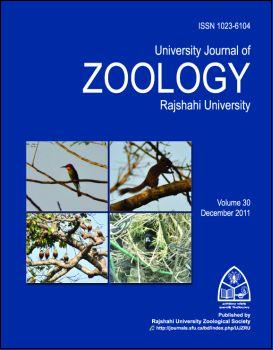Diversity of avifauna at the Bangladesh Academy for Rural Development (BARD), Kotbari, Comilla
DOI:
https://doi.org/10.3329/ujzru.v30i0.10746Keywords:
Ecology, diversity, avifauna, BARD, conservation.Abstract
The diversity of avifauna at the BARD (Bangladesh Academy for Rural Development), Comilla was studied from March, 2010 to March, 2011. A total of 41 species of birds (20 non-passerines and 21passerines) were identified. Among the total species, 37 (90.25%) were resident and 4 (9.75%) were winter migrants. Regarding to the habitat types utilized by individual species, 11 was bush dwellers, 5 at open place, 5 on human habitations, 4 on tall trees, 10 in garden, 6 found at near the pond. Relative abundance (by number) showed that 10 species were very common, 25 common, 9 fairly common and 7 few. The highest density was recorded for Passer domesticus (480.15 indiv. / acre) and the lowest was for Dicrurus macrocercus (1.29 indiv. / acre). Among these birds, 18 (43.91%) species were insectivores, 6 (14.64%) piscivores, 6 (14.64%) granivores, 2 (4.88%) frugivores, 4 (9.76%) rodentivores, only one (2.44%) nectar feeder and the rest 3 (7.32%) were mixed feeders. Among the avifauna, 8 (21.63%) species were included in the threatened category, of which 2 (5.41%) were critically endangered, 3 (8.11%) endangered and 3 (8.11%) vulnerable nationally. Direct communication with local people recorded that illegal exploitation of forest, trapping, shooting of birds and collection of young as cage birds are the mentionable causes of decline of the diversity and population of avifauna in the study area. Control of unwise exploitation, plantation of indigenous fruit-trees and creation of awareness, preparation of integrated management action plan (IMAP) and its implementation in co-operation with National and International organizations are mostly essential for conservation of avian diversity in the study area.
DOI: http://dx.doi.org/10.3329/ujzru.v30i0.10746
Univ. j. zool. Rajshahi Univ. Vol. 30, 2011 pp. 41-44
Downloads
217
434

